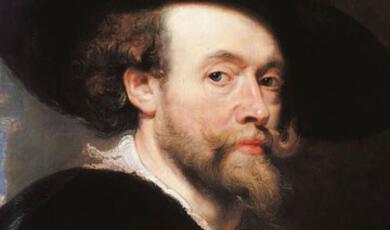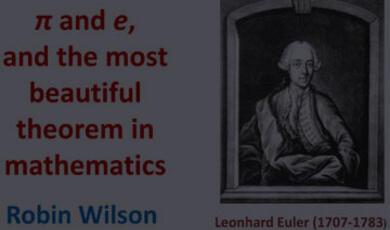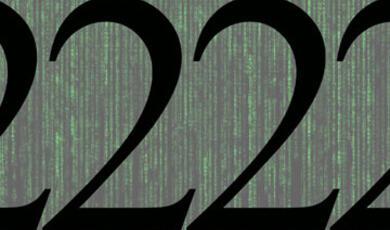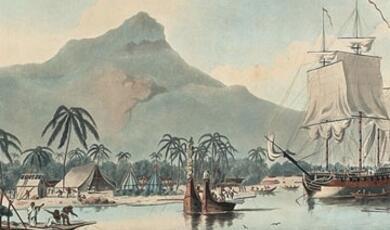Hans Holbein the Younger: 'a man very excellent in taking of physionamies'
Share
- Details
- Text
- Audio
- Downloads
- Extra Reading
Hans Holbein the Younger, portraitist, muralist, designer of jewellery and precious metalware, spent half of his distinguished career in London during the turbulent reign of King Henry VIII.
Arriving in 1526 as a German speaking citizen of the city of Basel, Switzerland, he swiftly rose to become a court painter trusted to provide the likenesses of the King's potential Queens.
This lecture will explore Holbein's work as a resident of the City of London, and examine the tensions between artists of the court and the City as well as the synergies between London and the continent which made the Tudor metropolis a magnet for foreign artists seeking fame and fortune.
Part of the Mondays at One series on Artists in London
Download Text
06 June 2016
Hans Holbein the Younger:
‘A man very excellent in taking of physionamies’
Dr Susan Foister, National Gallery
Towards the end of 1526 a twenty eight year old German immigrant named Hans Holbein the Younger arrived in London. Born in Augsburg, he had spent the previous decade establishing a successful career as a painter and designer in Basel in Switzerland. Now, in Erasmus’s words ‘the arts were freezing’ – the Reformation was already affecting the livelihood of artists in Germany- and he was seeking work in England. In December Erasmus’s English correspondent, Sir Thomas More, was gloomy about his chances of finding any: ‘I am afraid he will not find England as fruitful and fertile ground as he had hoped’. He promised to do what he could to help.
We can imagine Holbein as he crossed the English Channel from Antwerp, where he had stayed on his journey, wondering about how he would manage life in London. How would he deal with negotiations in English? Where would he find working premises? How would he buy his materials and what was available in England? With whom would he be able to forge useful working alliances, and what would the competition be like? The most populated part of London in the sixteenth century was of course the City which you see here on the right. To the far left is Westminster, where in the following decade Henry VIII would focus on the magnificence of his palace of Whitehall, to which Holbein would make a significant contribution, as we shall see. Out of the picture to the right, further down the Thames, was Greenwich Palace, where Holbein was to make his impressive court debut in 1527.
Foreign artists and craftspeople had long settled in London. This is a portrait of a Venetian diplomat and future doge, Marco Barbarigo, painted when he resided in London from the mid 1440s to at least 1450, as the letter addressed to him there which he holds demonstrates. It provides one concrete example of the work of a painter working in London who was clearly trained in the Netherlandish tradition. The art of making life-like portraiture, as we shall see, is a skill which those from abroad may have been better qualified to supply than native London artists.
The guilds were fiercely protective of their native members’ opportunities: in 1492 the ordinances of the painters company of the city of London laid down that no one should employ a painter from outside the city if they could get a freeman of the city for the same price. In 1517 there were riots in protest against foreign workers, especially glaziers from the Low Countries. Those from outside London and from Europe therefore tended to live on the margins of the city: Westminster was popular, because of the ecclesiastical work on offer, and many German speaking goldsmiths settled there. Southwark was another location popular with immigrants including painters. Holbein though is documented in 1541 living in the parish of St Andrew Undershaft in Aldgate Ward. In the same year he became an English denizen or resident – war with France forced alien residents to choose between denizenship or expulsion.
Greenwich and beyond: 1526-8
Holbein need not have worried about his future prospects in London, for, in just over two months time, by February 1527, he was at work on the site of Henry VIII’s palace at Greenwich. At the rate of 4s a day he was by far the best paid artist or craftsman involved in the preparations for the entertaining there of the embassy from France which would take place in May. He was one of several European artists working there alongside a large team of English painters.
Holbein and others were engaged in the preparation of two linked spaces: a banqueting house and a theatre or ‘disguising house’. The tasks involved can be traced through the surviving account books, principally one which records in summary the materials used for the banqueting house and the payments to the workers at particular periods, and a similar record for the theatre, which records of precisely which painters and other craftsmen were at work on any day between January and early May 1527.
The main focus of work in the banqueting house was the triumphal arch or screen, which was decorated with gilded heads of Roman emperors supplied by the Italian Giovanni da Maiano. On its reverse the arch featured a painting. This, supplied by ‘Master Hans’, identifiable as Holbein, for the large sum of £ 4, was a representation on canvas of the battle of Therouanne in which the English defeated the French in 1513. Henry VIII amused himself – if not his French guests- by revealing this highly undiplomatic scene as they passed through the arch on their way to the theatre after dinner. The painting may have been similar to this drawing now at Basel.
The theatre was dominated by its painted ceiling, which may have resembled this woodcut map of the world by Holbein, made for a publication by Sebastian Munster of 1532; the woodcut may even have been inspired by it. As described in Hall’s chronicle it showed the earth and sea, on which the zodiac, the five girdles and the two poles ‘appeared’ ‘by a cunning making of another cloth’ and also the planetary deities in their ‘houses’. Holbein was paid 4s a day for working with the royal astronomer Nikolaus Kratzer and a group of other painters to produce this painted ceiling.
It is remarkable that Holbein’s talents were recognised so swiftly that he was given a major role at court within such a short time of his arrival in England. How did this propitious start to the German immigrant’s career in England occur? England was not the first country he had tried – in 1524 he had travelled to France and reached the Loire, but returned to Basel. Holbein’s chances of success at Henry VIII’s court must have seemed substantial: not only was he an immensely skilful painter, but his design skills were formidable. In Augsburg he was probably trained in collaborating with sculptors and metalworkers, like his father, there were German metalworkers at the armouries at Greenwich, as well as gilders working on the roof of the theatre there. In Basel Holbein designed woodcuts for the burgeoning printing industry as well as stained glass. He was a master of working on different scales and had enormous powers of invention using perspective and the novel Renaissance decorative motifs which were conquering Northern Europe. Such skills were eminently adaptable to different environments, and especially to that of the court, where the need for prestigious imagery and artefacts for court ceremonies, court buildings and diplomatic exchange was constant, particularly since, as at Greenwich, much was ephemeral, produced only to be thrown out to make way for the next occasion.
But Holbein also had exceptional skills as a portraitist, as well as powerful contacts via Erasmus: these men were likely to have provided introductions to those overseeing the Greenwich festivities, rather than fellow-German speaking craftsmen. Portraits and further opportunities came out of the months there. The portrait of the King’s German astronomer Nicolaus Kratzer, for example, painted in 1528, showing him at work on creating instruments. Kratzer, the king’s astronomer, began an association with Holbein at Greenwich which lasted until the painter’s death in 1543. Their first collaboration was on this manuscript made as a New Year’s gift for King Henry VIII in 1529– Holbein provided the illuminated letters. Their last collaboration was on this clocksalt designed by Holbein which Sir Anthony Denny presented to Henry VIII as a New Year’s gift in 1544. The inscription is in Kratzer’s hand. We do not know the name of the maker but it would have required a skilled metalworker likely to have been from Northern Europe, and it is highly probable that Kratzer had formed links with German goldsmiths for the creation of such items, which would also have been of great use for Holbein in his career at court.
The City and Westminster: work for the King
At Greenwich Holbein worked alongside English painters who were members of the Painter-Stainers Company and who also worked constantly at court, on large decorative projects as well as routine maintenance. The Greenwich documents list the teams of Company painters in regular order, with their payments. The painters were led by John Brown, the King’s Painter and head of the London Painter-Stainers Company. He was responsible for much of the supply of decorative and heraldic painting for use in court ceremonial and at war in the first quarter of the sixteenth century, from flags for the Great Harry and other ships, standards for the army sent to France in 1523 and cloths painted with antique work for a court entertainment in 1524.
The fact that the head of the Company was responsible for carrying out painting for the King meant that the Company’s men constantly benefited from lucrative court work, a privilege to be defended against foreign incursion. During Henry VIII’s reign there was constant stream of work to be carried out especially in the 1530s on palaces including Whitehall and Hampton Court. But the work was largely decorative. Holbein could provide more.
Those employed by the King wore a livery embroidered with the initials HR. We don’t know who the sitters in these small portraits are or even whether the man was an artist. We don’t know if Holbein himself was required to wear a livery. But by 1532 he was back in London after a further four years in Basel and by 1536 he was referred to as Henry VIII’s painter. As we’ll see he was working for the King well before that date. The first salary payments of £30 a year survive from 1537 but Holbein may well have been salaried before then. There is unfortunately no document to tell us what the tasks were that the King demanded, but it’s likely that Holbein was valued for both his abilities as a designer and as a portraitist, a remit very different from that of John Brown and his successors.
He was greatly in demand on his return. The German Hanseatic merchants employed him as a portraitist and as a decorative artist. This very well preserved portrait of the merchant Hermann Wedigh dated 1532 shows him seated at a desk with a vivid blue background and with gilded lettering giving the year of his age, his 29th. In this way the portrait proclaims its status as a work of art as well as an imitation of reality. The German merchants also employed Holbein to decorate their hall, the Steelyard on the site of Cannon Street station, with decorative paintings, now lost, representing appropriately the triumphs of Riches and Poverty.
Very soon after his return to England it appears that Holbein was already working for King Henry VIII for he produced this design for a table fountain for the king to give to Anne Boleyn at New Year 1534, featuring her coat of arms: their marriage took place in 1533. Very few pieces survive once owned by the King but this clock salt gives an idea of their magnificence and of the fashionability of the Renaissance style designs in which Holbein excelled.
In Holbein’s native Augsburg the skills of the artist designer whose work was then produced by associated stained glass makers, goldsmiths and sculptors was becoming paramount, and these skills could be exploited by rulers. Distinctive invention was a mark of prestige, going beyond the mere distinction offered by heraldry. It may thus have been as important for Holbein to create designs for royal goldsmiths work as to produce portraits. In fact very few portraits survive which we can be certain Holbein produced for Henry VIII. This exquisite small portrait of Henry may have been intended as a diplomatic gift, perhaps for the King of France. This portrait of the infant Edward was given by Holbein himself as a New Year’s gift to the King in 1539. It shows him with a rattle instead of the royal orb of majesty, and with lines in Latin composed by the humanist political writer Richard Morison which flatter the child’s royal father. Next to it you can see another image of Edward with his pet dog surrounded by acorns, a roundel which appears to have been produced as a decorative design for a medal or an engraving on precious stone.
Excellence in taking physionamies
The drawings of Sir Thomas Elyot and his wife Margaret remind us of how difficult it was to obtain portraits made from sittings with an artist in England before Holbein's arrival. Sir Thomas Elyot wrote in his 'Boke named the Governour' in 1531 'If we will have anything well painted carved or embroidered ... we are 'constrained to resort unto strangers', and urged the apprenticeship of all talented native English boys. This beautiful drawing, which probably dates from within a couple of years of this statement, is characteristic of those associated with Holbein's second visit to London in the 1530s: the face and upper part of the body are sketched in coloured chalks on paper which has been covered in a flesh coloured preparation, perhaps one of a range of tinted papers prepared in advance so the choice of a particular pink could be calibrated to the observation of the subject’s complexion. The details of the head are sparingly reinforced in black ink, using a pen and brush to suggest differences between the growth of eyebrows, of stubble and of the rather lank hair under the cap.
Holbein's arrival in London for the second time effected a transformation in a very short period. If native talent was not being harvested, at least large numbers of courtiers such as Elyot were now acquiring painted images of themselves of extraordinary quality, where none had existed before. In an age when looking in a mirror and seeing an undistorted self-image was not an everyday experience, the effect of owning such a portrait must have been astounding. Holbein's sitters included the holders of the great offices of state, members of the Privy Council and the Royal Household, the peers of England and their wives, sons and daughters. Holbein portrayed around a quarter of the peerage or their families, a very substantial proportion when it is considered that many did not come to court, because they were too old or too impoverished or disliked the political changes of the time.
Nearly one hundred preparatory drawings for painted portraits survive, dating from the two periods, 1526-8 and 1532-43, when Holbein worked in England. The vast majority is in the Royal Collection at Windsor Castle, and most of the portrait drawings are named. Although the inscriptions are not contemporary, we know from a sixteenth century inventory of the drawings that the original identifications were made not long after Holbein's death, and many of these identifications can be corroborated in other ways.
In his painted portrait of 1536 Sir Richard Southwell wears a chain of knighthood, roughly sketched in the preparatory drawing for it. In his will Southwell, who died in 1564, refers to the 'cheine of golde which I myself was wounte to weare in fouldes aboute my neck'. The half-length portrait is apparently simple and restrained, the focus on the face, but the cast shadow and inscription suggesting as in the portrait of the Hanseatic merchant Wedigh, that the painting provides a richly deceptively illusion, one which calls attention to the artist’s skill in making it. In the drawing for the portrait there is unusually an inscription noting the eyes of the sitter were a little yellowish. It is also unusual that Holbein includes the inscription, a rare indication in a portrait drawing of the finished composition. Finally note the carefully deceptive drawing of a scar on Southwell’s neck exactly translated into the finished painted portrait. Importantly the drawing of the head can be shown to be exactly the same size as the painting. We can therefore deduce from this and other examples that tracing was used by Holbein to transfer the likenesses from drawing to panel, probably using carbon coated paper between the two.
Here you see the portrait drawing that was used to produce the portrait of the elderly and somewhat weary seeming archbishop of Canterbury William Warham in 1527, a painted portrait made to be sent to his patron Erasmus in Basel and one which was modelled closely on the image Holbein had made of Erasmus in 1523 and sent to him. Again, the head in the drawing is exactly the same size as that in the painting. What is notable here is that the drawing is made with coloured chalks on off-white paper and is somewhat larger than the drawings on pink-primed paper Holbein was to make on his second visit to London.
This miniature probably represents the wife of one of those most successful in the Tudor courtier’s game of power and personal enrichment, Sir Thomas Audley, the Lord Chancellor, one of the beneficiaries of the wealth from the Dissolution of the Monasteries, who married in 1538 as his second wife Elizabeth Grey. In the drawing of Lady Audley metalpoint describes her jewels, while the restrained ink outline beautifully rims her features . The notes indicate she is to be dressed in red damask with velvet sleeves as in the portrait miniature - but was there also a full size painted portrait? We do not know.
We have only one glimpse of Holbein at work provided by contemporary documents, which indicates clearly that he worked initially from sittings from the life, in the presence of the sitter. This occurs in March 1538, when Holbein, described on this occasion as 'a man very excellent in taking of physionamies', had been sent to Brussels by Henry VIII in order to take the likeness of Christina of Denmark, the sixteen year old widowed Duchess of Milan. The final result of that journey is of course the full-length portrait of Christina in the National Gallery. But would Holbein have taken such a large panel with him over to Brussels? It seems unlikely. Holbein had a sitting with Christina which lasted three hours, long enough probably to make several drawings, none of which survive, but not long enough to paint a full-size picture in oils. The immediate result we are told was 'very perfight', and evidently delighted Henry on Holbein's return, for we are told that this likeness pleased him so much that 'since he saw it he has been in much better humour than he ever was, making musicians play on their instruments all day long'. We must presume that Holbein then worked up the painting from whatever he had brought back, a drawing of the head, possibly a study of the costume, and perhaps on this occasion a sketch of the hands, for the hands are particularly beautifully portrayed.
There may also have been studies of Christina’s black mourning dress perhaps like this one in the British Museum showing front and back of a woman’s dress. Holbein may also have wanted to record the textiles from which her clothing was made, here the black satin which in the portrait he paints so effectively, so annotations such as those we see here in this drawing of a man would have been vital. There would certainly have been a drawing of her face, all important for Henry. It was reported Christina had dimples evident when she smiled: ‘Ther is non in theis parties off parsonage, beawtie, and byrthe lyke unto the Duches off Myllayn. She is not soo pewre whyt, as was the late Qweyn, whois soal God pardon; but she hathe a syngular good countenaunce, and when she chancesithe to smyl, ther aperithe two pittes in hir cheikes, and wone in hyr chyne, the wiche becommythe hyr right excellently well’. Christina was said to have resembled a certain Mistress Shelton, who may be the woman in the drawing on the left. The drawing Holbein made was probably more like that of Lady Parker you can see on the right.
Creating a Composition
This portrait of a woman who is almost certainly Anne Lovell was evidently made for her husband, Sir Francis Lovell, perhaps around the time she gave birth to their son and heir. On her lap is a squirrel, the Lovell emblem, and at her shoulder a starling, perhaps a pun on the location of their Norfolk seat, East Harling. No drawings for this portrait survive but one way of finding out a good deal about how Holbein used his drawings to make painted portraits is with the aid of infrared reflectograms. We can look through the surface paint of the portrait of Anne Lovell and see some slight but beautifully fluid brush drawing delineating folds in the shawl which were not always followed by the surface painting,. Crucially there is no visible drawing in the contours of the face, which must have been traced from a drawing, although minor alterations were made in the course of painting to the hairline and the contour of the cap. We can see here a clear distinction between the lack of alteration to the face, and the major alterations Holbein felt free to make to the rest of the picture. The background, the presence of the squirrel and the starling and even the position of the sitter's hands were the result of later decisions, perhaps some time after the initial sketch for the head. But it seems the portrait drawings were vital in enabling Holbein to transfer with precision to the painted likeness the exact likeness he had produced during a sitting.
The Comptroller of the Royal Households and Master of the Revels, Sir Henry Guildford, had overall charge of the festivities at Greenwich, and ultimate responsibility for employing Holbein there in 1527 on his first visit to London. Holbein showed him in the same year, along with his wife, resplendent in costly gold damask and wearing the collar of the royal Order of the Garter. In Lady Guildford’s portrait her evidently smaller figure is balanced with a highly elegant and fashionable Renaissance column not dissimilar to the pilaster shown in the portrait of Erasmus owned by Archbishop Warham. The decorations and architectural framework of the entertainment halls at Greenwich were all in this highly fashionable ‘antique work’ style. The bulky, richly dressed figure of the powerful Sir Henry already sends a signal of how Holbein will create his iconic portrait of Henry VIII – and possibly alerted the King to the exceptional powers of the artist he would shortly lose for four years.
A preparatory drawing for Guildford's portrait also survives, but the correspondence between the outlines of painting and drawing is not so exact here. The face of the painting has been elongated, perhaps in order to flatter slightly the bulky figure that Guildford presented. Neither X-rays nor infra-red photographs reveal alterations to the proportions of Guildford's face during the process of working up the painting, so it is probable that Holbein corrected the portrait by eye as he worked, after transferring the whole drawing to the panel. – you see here the drawing, painting and infrared superimposed.
This drawing in Basel of a half-smiling Lady Guildford was once thought to have been discarded before Holbein made the finished painting from a second, lost preparatory drawing. However, we now know this is not the case: the outlines of painting and drawing correspond precisely, and it is clear from study of the underdrawing that the features of Lady Guildford were merely moved round her face and her smile removed, to be replaced by an expression of solemnity for the painted portrait. It was just such a combination of imaginative and technical skills that was at work in the creation of the image of Henry VIII.
In 1537 Holbein produced his masterpiece in painting for the King: the Whitehall wall painting which was burned down along with the palace in 1698. This is the small copy made for Charles II. The original mural was made for the Privy Chamber, a semi-private room in which the King would receive the most illustrious of guests, and would impress them with this life-size image of the Tudor dynasty, Henry VIII and his father Henry VII with their wives, Elizabeth of York and Henry’s third wife Jane Seymour who was to bear his son Edward VI. The tablet between them is inscribed with Latin verse which asks which King is the greater, the father who reconciled the warring kingdom, or the son who brought about the break with papal Rome and established the English church.
Only one drawing survives for this commission -the cartoon for the left hand part of the Whitehall wall painting today in the National Portrait Gallery. This cartoon is of course a different kind of working drawing to those we have seen so far: it served as the final preparatory stage for a much larger painting than usual, on a different surface to the smaller panels, and it was used in a different way. The outlines were pricked and charcoal dust was shaken through the holes onto the surface behind. When the cartoon was removed, the outlines made by the dust could be reinforced and the painting begun.
But there is one very important difference between the cartoon image and the famous image of the finished painting: the position of the heads, in three-quarter face in the cartoon and full-face in the painting, as we see in the copy. The cartoon is actually made up of several pieces of paper joined together, and the figures are themselves cut-outs, stuck down onto the background. They could presumably be more easily positioned in this way, then stuck down in their final attitudes. The head of the cartoon is also a separate piece of paper. The outlines of the head in three-quarter face must then have been transferred to the wall. Only at this point was the decision taken to turn the head to face us - a frontal view Holbein had already used in several earlier portraits. It would have been a relatively simple matter for Holbein to alter the contour of the head slightly, slip the features round Henry's face and manoeuvre them to the front for posterity.
In the more usual type of portrait drawing of Jane Seymour the Queen is shown wearing a dress with pleated linen undersleeves and pearls and a pendant jewel around her neck. But in the full-length portrait of the Queen in the lost wall-painting at Whitehall palace, in which she represents the only Tudor Queen of the current generation to have born a living son, she wears far grander jewellery and clothes although her pose is exactly the same: her gown is of cloth of gold, her sleeves of ermine and she wears massed gold chains across her bodice. And in the portrait at Vienna, which is exactly the same size as the drawing, her ensemble is different again: her undersleeves are of looped gold brocade and her oversleeves of gold net over red velvet, her necklace not plain pearls but a more elaborate arrangement of pearls and precious stones matching her headdress. Her girdle resembles the jewels listed in her inventory as pots of gold and lapis lazuli. These different parts of her costume would in life have been assembled and pinned on separately, therefore it was a simple matter for sleeves and jewels to be upgraded from drawing to the sumptuous textiles of this portrait and the grandeur of the wall painting. The Queen's presence, once the drawing was made, was not required, and indeed we cannot be certain that she was still alive when the wall painting was completed in 1537.
The extent to which large-scale compositions called for such maneouvres can be seen in Holbein's portrait of the family of Sir Thomas More, or at least in the studies for it, for the painting itself, which was on a fine linen canvas, was destroyed in the eighteenth century: this is an annotated working drawing, probably an intermediate stage at which Holbein had settled on the composition, but needed to discuss it further with More, its commissioner. Did Holbein then have the More family sitting before him to draw, apparently at family prayers? There is very good evidence that he did not. Several individual studies for the portraits of the Mores survive at Windsor. The wonderfully bold chalk study of John More shows him much as he appears in the group: but Holbein has removed his hat. The drawing of Anne Cresacre gives the game away completely: she is clearly seated in a chair, but in the group Holbein makes her stand. Holbein might take the appearances of his sitters from the life, but their poses and indeed the composition of a large painting such as this, might be quite imaginary. Like other artists, Holbein may not have felt obliged to use the sitters themselves for models when trying to work out how they should look at full-length. In fact a great deal could be added or assembled or altered later as we have seen: jewellery and costumes certainly, but also bodies and even hands as well as backgrounds. Virtually all Holbein's surviving portrait studies show only the upper part of the sitter's bodies, and often only heads and shoulders; very few include hands, hardly any have any indication of background. But although most drawings are slightly cut it is clear that the head is the principal focus, and it is this which Holbein worked up in the sitter's presence, in the very first stage of the encounter between sitter and artist.
In 1533 Holbein painted one of the most extraordinary works of his career: the double full-length portrait of Jean de Dinteville and his friend George de Selve. Dinteville was the French ambassador in 1533, bored with waiting on the coronation of Anne Boleyn and then on the birth of her child, the future Elizabeth I. De Selve was his friend, on a short secret mission probably from April to June, which cheered him. The painting commemorated the visit and the friendship and was destined for Dinteville’s French chateau of Polisy. The painting pivots between the distorted shape of the skull in the centre, which clicks into shape if the viewer stands on the right and the half hidden image of the crucifix top left, the hope of resurrection. Between the two men is an array of astronomical instruments and objects of earthly utility. Especially notable are the lute with its broken string, and the Lutheran hymnbook next to de Selve: his attempts to reconcile the deep divisions in Christendom between Catholics and Lutherans may have inspired their presence.
The two diplomats in the 'Ambassadors' look uncannily as though they are posing for the camera, but such a large composition, (for which, unfortunately, no drawings survive), could hardly be realised without a great deal of work in constructing it: can we really believe that the two men posed at the same time in a room just like this and with a piece of furniture loaded with globes, musical instruments and astronomical instruments arranged between them? Were any of these objects even their own possessions? Even that seems unlikely. The instruments were almost certainly owned by Holbein's friend, the King's astronomer and a fellow German, Nikolaus Kratzer, who is shown in Holbein's portrait of 1528 in the Louvre making one of them, and Holbein may well have kept detailed drawings of the instruments to use again. The terrestrial globe appears to have been based on a real globe, perhaps again Kratzer's, but here Holbein has edited the original and inscribed on the map of France not only the area, Burgundy, in which Jean de Dinteville (whom we saw on the left) resided, but also Polisy, the location of his chateau, where the painting subsequently hung.
The whole composition was surely inspired by Holbein’s woodcut for the Dance of Death, a series of small exquisitely designed narratives of the ways in which death carries off those in the midst of life when they were least expecting it. Here, in the final woodcut at the end of the book, a man and woman stand to either side of a shield with a decaying death’s head and above bony arms reaching up to bring down a rock to smash an hourglass, a device for measuring time. Painting and woodcut demonstrate the extraordinary abilities Holbein brought to London: as an artist, as a designer and as a man who could capture likeness. They also reminds us that his career was cut short in the autumn of 1543 when he died suddenly, probably from the plague which was then raging in London.
© Dr Susan Foister, 2016
Part of:
This event was on Mon, 06 Jun 2016
Support Gresham
Gresham College has offered an outstanding education to the public free of charge for over 400 years. Today, Gresham College plays an important role in fostering a love of learning and a greater understanding of ourselves and the world around us. Your donation will help to widen our reach and to broaden our audience, allowing more people to benefit from a high-quality education from some of the brightest minds.


 Login
Login







